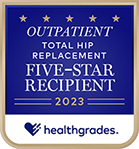
Orthopedic experts say yes—and explain how to find relief.

Maybe your grandma always said she could tell a bad storm was coming because she felt pain in her knee—or maybe you say so yourself. Is this connection mere coincidence or cold, hard fact?
It turns out that “feeling it in your bones” may be an accurate weather forecaster. But it’s not the bones that provide this predictive power. Instead, it’s the joints.
“Our joints are like barometers,” says Stephen Kayiaros, MD, a board-certified, fellowship-trained orthopedic surgeon at Robert Wood Johnson University Hospital (RWJUH) Somerset. “When weather gets colder and damper, it creates inflammation in the joints, especially among people who have preexisting conditions such as arthritis or synovitis [swelling of joint linings].” That inflammation can create pain, stiffness and swelling.

Some evidence suggests that falling air pressure may cause bones, muscles and tendons to expand, boosting pressure in joints and making them more painful to move.
Weather to Watch For
People with arthritis in their shoulders, knees or hips—or those with prior joint injuries that caused cartilage damage— can be on the lookout for two weather conditions that may affect joint pain during the fall and winter.
- Quick atmospheric changes: “Oncoming storms cause barometric pressure to rise or fall rapidly, and injured or arthritic joints can’t adjust quickly,” says Michael Duch, MD, a board-certified and fellowship-trained orthopedic surgeon at RWJUH Hamilton and a member of RWJBarnabas Health Medical Group.
- Colder temperatures: “When the weather gets colder, your circulation begins to slow, which can cause muscle spasms and stiffness,” Dr. Duch says. Some research indicates that colder air may also thicken lubricating fluid in joints and make them stiffer. In addition, people tend to be less active when the mercury plunges, which can promote stiffness and inflammation.
How To Cope
While you can’t avoid weather changes entirely, you can take steps to lessen the impact of winter elements on achy joints. A few tips:
- Keep moving. While not always easy in chilly conditions, there are ways to stay active. One option is to join a gym or local YMCA. Another is to walk inside a mall or even your own house. “Having a good exercise and stretching program that you adhere to three or four times a week will promote good, healthy joints and prevent layers of inflammation,” Dr. Kayiaros says.
- Use a compression sleeve. Wearing a thin sleeve on your knee or elbow can have two potential benefits. “It will keep your joint a little warmer, and it will provide a bit of extra stability if your joints feel slightly unstable when you put weight on them,” Dr. Duch says.
- Try conservative treatments. Over-the-counter medicines like acetaminophen or ibuprofen can help treat periodic pain. If pain is continuous, orthopedic and sports medicine specialists may recommend treatments like cortisone injections or prescription medications.
Factors Beyond Forecasts
Having pain when the weather changes is one thing. Dealing with pain so intense or frequent that it impairs your quality of life is another. If joint discomfort becomes chronic and increasingly intolerable, it may be time to consider surgery. Options include:
- Arthroscopic surgery: Arthroscopy uses a tiny camera and small incisions to view, diagnose and treat knee, hip and shoulder pain. This proven technique can be used to fix rotator cuffs, ease pain from achy joints, repair meniscus tears and reconstruct major ligaments. “By using special, small instruments inside the joint, we can repair damage and minimize impact to surrounding soft tissues,” Dr. Kayiaros says.
- Joint replacement surgery: Recommended in cases of severe arthritis, these procedures replace deteriorated joints with prosthetic implants made from plastic and titanium.
- Advanced technology: While joint replacement surgery is traditionally an open procedure, surgeons today use innovative technologies both before and during the operation to help patients reduce pain and recover faster.
Dr. Kayiaros uses a handheld device called OrthAlign to deliver computer-assisted knee replacement surgery. “OrthAlign gives me real-time information that helps me properly align a prosthetic knee in relation to a patient’s anatomy,” Dr. Kayiaros says.
Dr. Duch performs Mako robotic-arm-assisted knee replacement surgery. Mako allows surgeons to plan a procedure based on a patient’s CT scan and ensure precise incisions and proper knee balancing during the replacement. “We’ve seen outstanding results with patients who have had Mako-assisted joint replacement surgery,” Dr. Duch says.
Only the person experiencing pain can know whether it ebbs and flows due to factors like the weather or is so persistent and difficult that surgery might be the right solution. “I always tell my patients, ‘It’s not up to me to decide when you need surgery,’” Dr. Duch says. “Patients need to decide if surgery is right for them based on their own symptoms.”
Underway: A New Orthopedic Pavilion

A new two-story vertical addition now under construction at Robert Wood Johnson University Hospital Somerset is more than halfway to completion. Scheduled to open in fall 2024, the 76,600-square-foot space will include:
- An Orthopedic Center of Excellence featuring 35 private inpatient rooms with amenities such as convertible sleeper sofas and USB ports and a state-of-the-art rehabilitation gym
- A 10-room Rapid Decision Unit for Emergency Department patients who need additional observation or are awaiting test results
Honored for Orthopedic Care


Robert Wood Johnson University Hospital (RWJUH) in New Brunswick and RWJUH Somerset recently received national recognition for their orthopedic care:
- RWJUH in New Brunswick ranks as High Performing in hip replacement surgery by U.S. News & World Report.
- RWJUH Somerset is rated five stars for Outpatient Total Hip Replacement by Healthgrades.
To find an orthopedic specialist or learn more about joint care at RWJBarnabas Health, visit orthopedics services.
